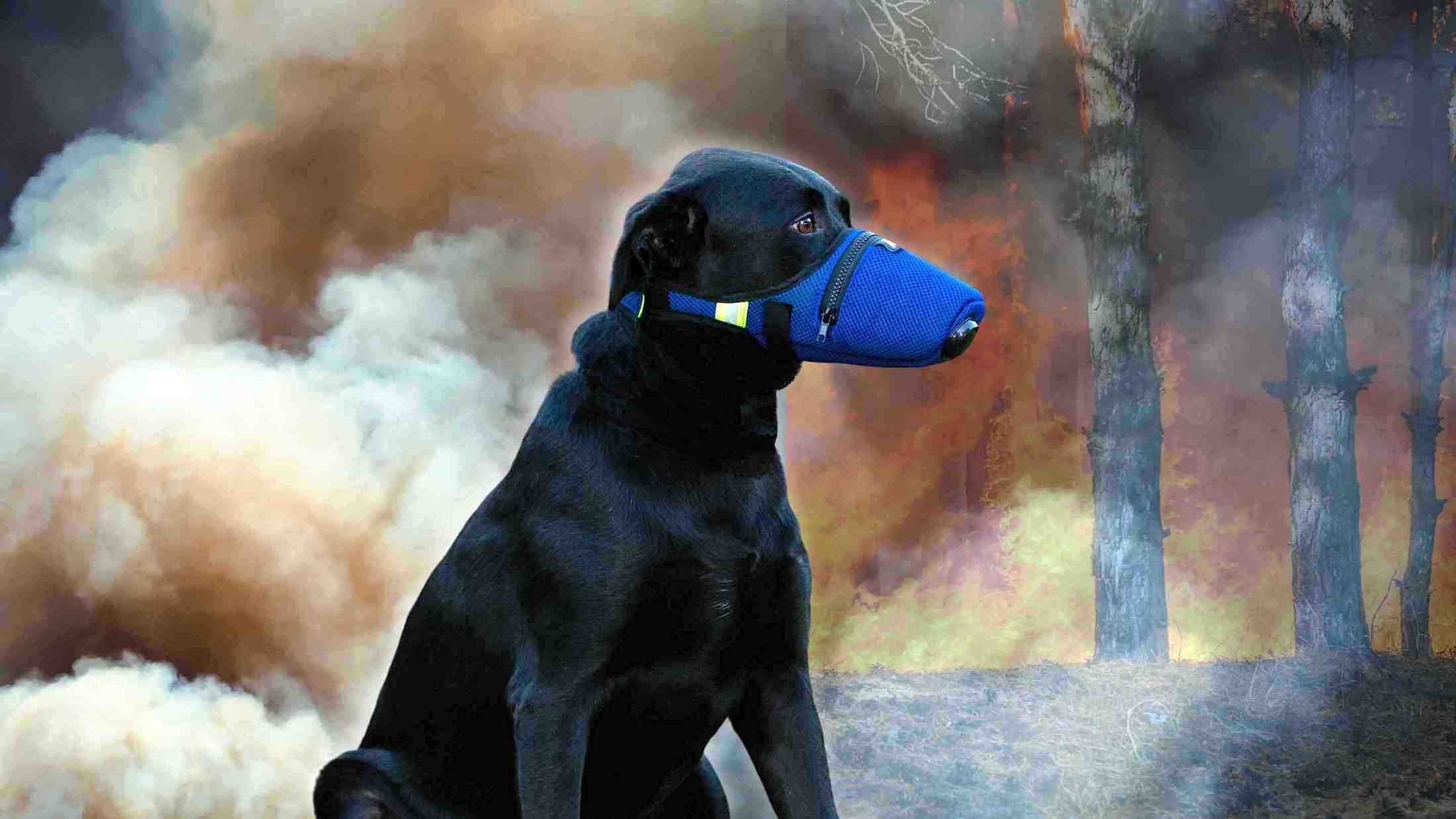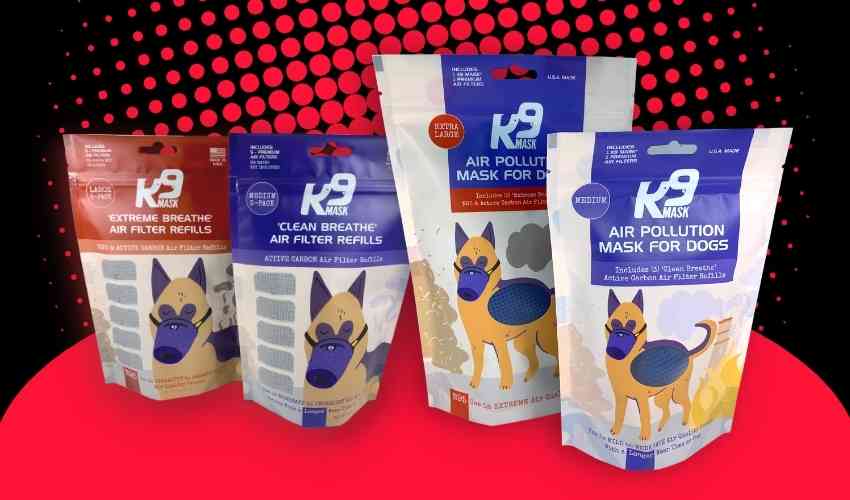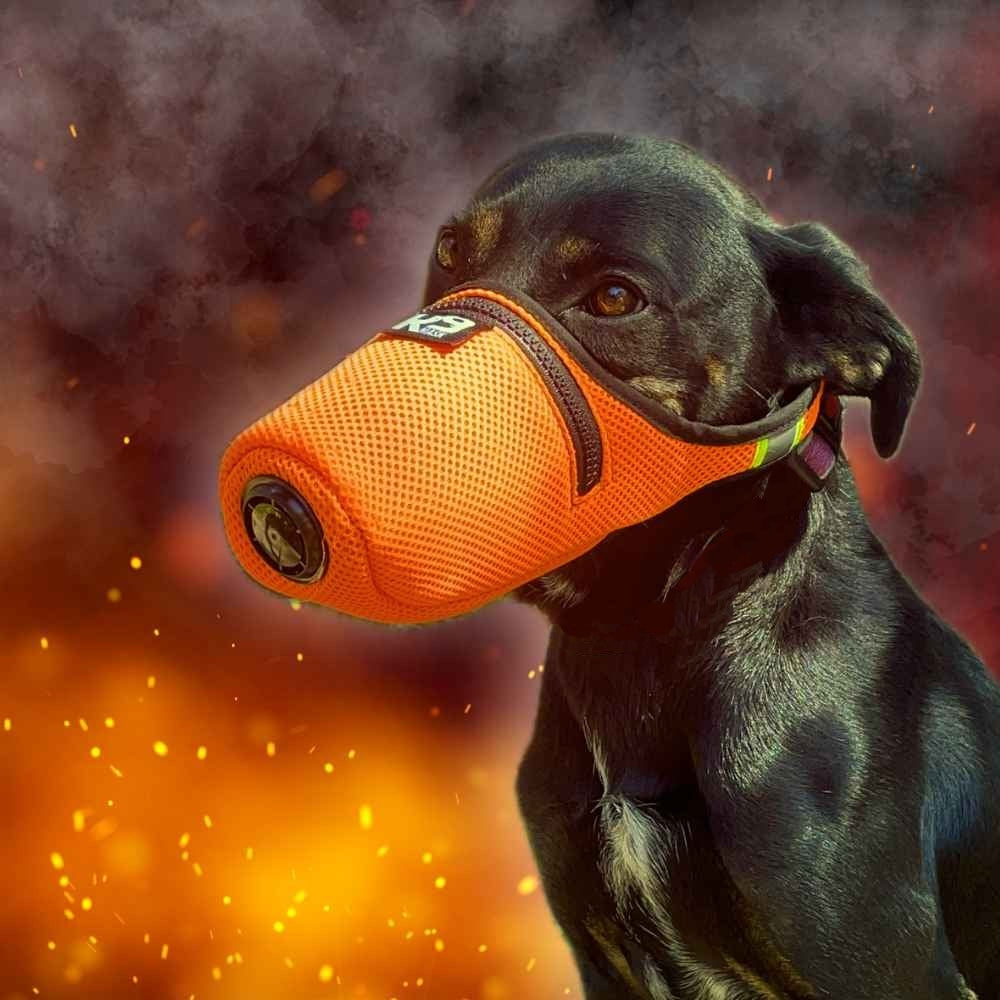K9 Mask® Air Filtration Test with ISO 16890 Results
K9 Mask® Air Filtration Test Results
K9 Mask® dog air filters have been certified by Blue Heaven Technologies in Louisville, Kentucky, USA with an ISO 16890 air filtration test for the Extreme Breathe and Clean Breathe air filters.
The International Organization for Standardization (ISO) has introduced ISO 16890, a new standard for testing and classification of air filters.

Performance Testing of Air Filters
The methods used for testing and classifying air filters involves a duct in which a filter is mounted in a controllable fan. A “test dust” is introduced upstream of the filter to challenge the unit and evaluate its performance. The test dust may be the particles already present in the ambient air, or it could be a laboratory prepared mixture of particles made to a “recipe” defined in the test standard.
Located upstream and downstream of the test filter are air samplers and particle counters. Particle counters are sensitive devices that count the number of airborne particles within a narrow size range. Using an array of counters, it is possible to simultaneously count a wide range of different sized particles. Comparing the particle counts upstream and downstream of the filter allows the efficiency of the filter to be determined for different size particles.
Test methods usually allow the efficiency of a filter to be determined in the “as-new” condition (clean) and also under conditions that simulate the changes anticipated during the working life of the filter.

The Ideal Filter Classification System
As a minimum, it seems reasonable that a filter classification system would provide clear information on the ability of a device to remove different size particles from the air that are relevant for individual customers.
The ISO 16890 is a significant harmonization for the air filtration industry. The key benefits for users of air filters include:
- An acknowledgement that air filters positively influence air quality and benefit health.
- Global applicability. One test and classification system to be utilized throughout the industry that can be readily understood by specifiers, purchasers and users of air filters.
- The ability to easily select and comprehend product value in relation to function and application.
Key Features of ISO 16890
Depending on achieved removal efficiency against different size particles, filters can be classified into one of four categories that relate directly to removal efficiency against PM2.5, PM10, and “coarse” particles; those larger than 10 microns.
The new standard establishes a minimum of 50% removal efficiency is required for inclusion in the three most demanding categories (very fine and medium particles); PM1.0, PM2.5 and PM10.
Under the new standard, a minimum of 50% removal efficiency after the discharge procedure is required for inclusion in all the categories (very fine or medium particles).
For PM2.5 and PM10 classifications, the reported efficiency (expressed in percentage] is the average value of the initial efficiency and the discharged efficiency values. As stated above, by the new standard both values must exceed 50%.

Key Definitions
Particulate matter is commonly defined in terms of physical size, usually expressed in microns. For example, each cubic meter of city center air contains many millions of suspended particles. They range in size from below 0.1 micron (nanoparticles) up to 100 microns.
Most particles, however, are smaller than 1 micron, and there are few particles greater than 25 microns that, due to their weight, are suspended.
Very fine particles mostly originate from combustion processes, principally vehicle engines, while larger particles originate from different sources including construction and nature; pollen, sand and, soil.
The level of particulate matter is being monitored and reported by dedicated website around the world. The traditional reporting categories are PM2.5 (particles < 2.5 microns) and PM10 (particles < 10 microns).
These are normally reported as a weight value with units of μg/m3 (micrograms per cubic meter). Increasingly, attention is shifting to even smaller particles as these are known to penetrate far deeper into the human body reaching critical organs such as the brain, heart and liver.

K9 Mask® ISO 16890 Filtration Test Results
K9 Mask® dog air filters have been certified by Blue Heaven Technologies in Louisville, Kentucky, USA with an ISO 16890 Air Filter Test for the Extreme Breathe (XTRM) and Clean Breathe (CLN) air filters.
This is a summary of the test results for these two air filters:
Extreme Breathe XTRM N95 Active Carbon Air Filter
- ✅ for PM2.5 effectiveness.
- View full K9 Mask® Extreme Breathe air filter laboratory certified results
|
Particulate Size (PM in microns) |
Initial Efficiency % |
Discharged Efficiency % |
| 0.3-0.4 | 99% | 42% |
| 0.4-0.55 | 99% | 53% |
| 0.55-0.7 | 99% | 63% |
| 0.7-1.0 | 99% | 73% |
| 1.0-1.3 | 99% | 84% |
| 1.3-1.6 | 100% | 90% |
| 1.6-2.0 | 100% | 95% |
| 2.0-3.0 | 100% | 99% |
| 3.0-4.0 | 100% | 100% |
| 4.0-5.5 | 100% | 100% |
| 5.5-7.0 | 100% | 100% |
| 7.0-10.0 | 100% | 100% |
Clean Breathe PM10+ Active Carbon Air Filter
- ✅ for PM10 effectiveness.
- View full K9 Mask® Clean Breathe air filter laboratory certified results
|
Particulate Size (PM in microns) |
Initial Efficiency % |
Discharged Efficiency % |
| 0.3-0.4 | 1% | 2% |
| 0.4-0.55 | 2% | 2% |
| 0.55-0.7 | 2% | 3% |
| 0.7-1.0 | 3% | 3% |
| 1.0-1.3 | 4% | 3% |
| 1.3-1.6 | 5% | 5% |
| 1.6-2.0 | 7% | 7% |
| 2.0-3.0 | 12% | 12% |
| 3.0-4.0 | 23% | 22% |
| 4.0-5.5 | 41% | 40% |
| 5.5-7.0 | 61% | 59% |
| 7.0-10.0 | 74% | 69% |








